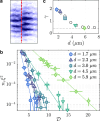Observation of a bilayer superfluid with interlayer coherence
- PMID: 40764293
- PMCID: PMC12325720
- DOI: 10.1038/s41467-025-62277-w
Observation of a bilayer superfluid with interlayer coherence
Abstract
Controlling the coupling between different degrees of freedom in many-body systems is a powerful technique for engineering novel phases of matter. We create a bilayer system of two-dimensional (2D) ultracold Bose gases and demonstrate the controlled generation of bulk coherence through tunable interlayer Josephson coupling. We probe the resulting correlation properties of both phase modes of the bilayer system: the symmetric phase mode is studied via a noise-correlation method, while the antisymmetric phase fluctuations are directly captured by matter-wave interferometry. The measured correlation functions for both of these modes exhibit a crossover from short-range to quasi-long-range order above a coupling-dependent critical point, thus providing direct evidence of bilayer superfluidity mediated by interlayer coupling. We map out the phase diagram and interpret it with renormalization-group theory and Monte Carlo simulations. Additionally, we elucidate the underlying mechanism through the observation of suppressed vortex excitations in the antisymmetric mode.
© 2025. The Author(s).
Conflict of interest statement
Competing interests: The authors declare no competing interests.
Figures





References
-
- Makhlin, Y., Schön, G. & Shnirman, A. Quantum-state engineering with Josephson-junction devices. Rev. Mod. Phys.73, 357 (2001).
-
- Degen, C. L., Reinhard, F. & Cappellaro, P. Quantum sensing. Rev. Mod. Phys.89, 035002 (2017).
-
- Langen, T. et al. Experimental observation of a generalized Gibbs ensemble. Science348, 207 (2015). - PubMed
-
- Schweigler, T. et al. Experimental characterization of a quantum many-body system via higher-order correlations. Nature545, 323 (2017). - PubMed
-
- Berezinskii, V. Destruction of long-range order in one-dimensional and two-dimensional systems possessing a continuous symmetry group. II. Quantum systems. Sov. Phys. JETP34, 610 (1972).
LinkOut - more resources
Full Text Sources

